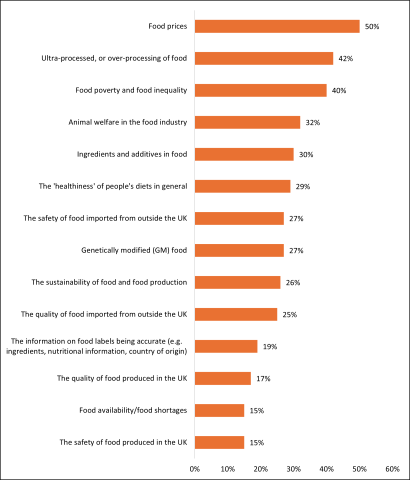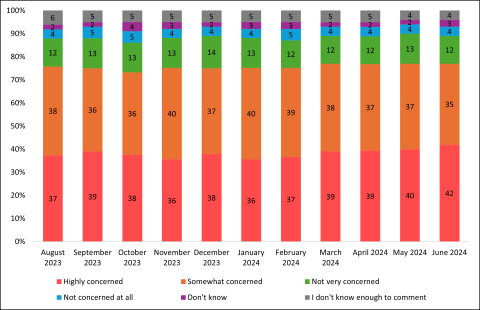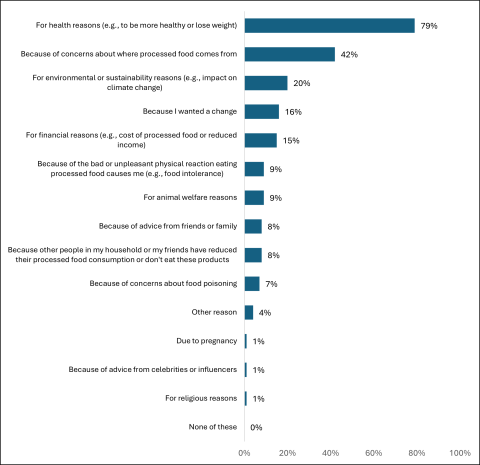Consumer concerns, beliefs and behaviours around ultra-processed foods
In this guide
In this guideOn this page
Skip the menu of subheadings on this page.Consumer concerns about UPFs
Since August 2023, the FSA’s Consumer Insights Tracker has collected data on consumer concerns about “ultra-processed or over-processing of food.” Specifically, respondents are presented with the question: “Thinking about food in the UK in general. At the moment, how concerned, if at all, do you feel about each of the following topics?” Respondents rate 14 items on a scale according to their level of concern, including that which relates to UPF.
In June 2024, 77% of respondents indicated that they were concerned about ultra-processed or over-processed food (Figure 4), second only to food prices (88%), but in a larger group of items including food poverty and food inequality (76%) and the ‘healthiness’ of people’s diets in general (75%).[1] In total, 42% of respondents indicated that they were ‘very concerned’ about ultra-processed or over-processed food, again second only to food prices (50%) and with food poverty and food inequality (40%) exhibiting a comparable level of concern (Figure 4).
Figure 4. Consumer concerns about food issues, June 2024
Source: FSA Consumer Insights Tracker (2024b) Q. Thinking about food in the UK in general. At the moment, how concerned, if at all, do you feel about each of the following topics? Base: June 2024 (n=2,056). Respondents were shown all of the topics listed and asked how concerned, if at all, they felt about each. Figures for ‘Concerned’ shown in chart are the proportion ‘highly concerned’ or ‘somewhat concerned’, and ‘Otherwise are the proportion ‘Not very concerned’ and ‘Not concerned at all’, ‘Don’t know’ or ‘Don’t know enough to comment’.
Figure 5. Proportion of consumers highly concerned about food issues, June 2024
Source: FSA Consumer Insights Tracker (2024b) Q. Thinking about food in the UK in general. At the moment, how concerned, if at all, do you feel about each of the following topics? Base: June 2024 (n=2,056). Respondents were shown all of the topics listed and asked how concerned, if at all, they felt about each. Figures shown in chart are the proportion ‘highly concerned’.
Looking to possible trends about UPFs over time, there is some evidence that concern has increased in recent months (Figure 6). In total, 36% of respondents indicated that they were ‘highly concerned’ about ultra-processed or over-processing of food in January 2024, increasing statistically significantly to 42% in June 2024. Over this same period, however, the proportion who exhibit concern (highly or somewhat concerned) has remained virtually unchanged, from 76% in January 2024 to 77% in June 2024.
Figure 6. Consumer concerns about ultra-processed or over-processing of food, August 2023 to June 2024
Source: FSA Consumer Insights Tracker (2024b) Q. Thinking about food in the UK in general. At the moment, how concerned, if at all, do you feel about each of the following topics? Base: approximately n=2,000 per month.
Data from Food and You 2 (FSA, 2024a) suggest that consumers in England, Wales and Northern Ireland exhibit a propensity to reduce consumption of processed foods. 43% of respondents to the survey in October 2023 – January 2024 (Wave 8) reported that they had reduced consumption of processed foods in the last 12 months. This was the most frequently reported change in food behaviour, followed by minimising food waste (38%). The most frequently cited reason for having reduced consumption of processed foods was health reasons or to lose weight (Figure 7).
Figure 7. Reasons for reducing consumption of processed foods in last 12 months
Source: FSA Food and You 2, Wave 8 (FSA, 2024a). Base: Online respondents who had eaten less processed food in the last 12 months (n=1,783)
In the FSA’s ‘The UK Public’s Interests, Needs and Concerns Around Food’ research, 61% of respondents expressed concerns about the ‘over-processing’ of food in the future (FSA, 2022a). Further, FSA research in 2018 provided evidence of consumer concerns about the longer-term health effects of consuming processed foods, and of the additives and levels of sugar, fat and salt these contain (FSA, 2018). Conversely, in a recent survey by IGD (2023), of the top factors influencing the food and drink products that consumers choose to buy, the level of processing ranked 16th, with the top factors being price, taste, quality and freshness.[2]
Consumer beliefs about UPFs
In trying to understand consumer beliefs and concerns about UPFs it is important to recognise that UPFs are on the continuum of unprocessed to processed foods, and reflect the centrality of consumer beliefs and concerns about food processing and processed foods in general. Indeed, in the context of information and choice overload, there is evidence that consumers give disproportionate importance to more salient and less complex information when making food choices, with (judgements of) the level of processing being a prominent cue (Koster, 2009).
There is a plentiful literature that suggests consumers make negative associations between industrial (as opposed to domestic) food processing and the healthiness of food (see for example, Machin et al., 2020); Aguirre et al., 2019), Bhawra et al., 2021), Dube et al., 2016). Processing, however, is not considered a linear attribute from ‘more’ to ‘less’. Instead, distinctions are made between processing methods that are considered traditional[3] (and that tend to be judged as more natural), rather than modern industrial processes (Etale and Siegrist, 2021) and/or that involve chemical processes (and that tend to be judged as less natural) than physical changes (Evans et al., 2010; Rozin, 2005). There is evidence, furthermore, that consumers distinguish between foods that are ‘home-made’ and that are industrially processed, such that processing is almost synonymous with industrial and commercial production (Devia et al., 2021; Rozin et al., 2004; Battacchi et al., 2020).
A prominent theme in the literature on consumer perceptions of processing in the context of food is the notion of ‘naturalness’ (Etale and Siegrist, 2021). In turn, perceptions of naturalness have been shown to be a key driver of consumer evaluations of taste, healthiness and sustainability, with more natural foods, for example being judged to be healthier and more sustainable (Hartmann et al., 2022, Roman et al., 2017; Peschel et al., 2019). Beyond the influence of organic versus conventional production, for example, the literature highlights the importance of the (perceived) age of a technology (with recency being evaluated negatively) and whether it is regarded as ‘traditional’ (Cerjak et al. 2011). Also, the degree of human contact in the production of a food (Abouab and Gomez, 2015), the scale of production (Etale and Siegris., 2021) and the use of machinery and automation, with a focus on efficiency of inputs and time rather than quality of the final product (Cirne et al. 2019). The more steps a food undergoes in its production, the less natural it tends to be perceived to be regardless of whether this process results in a nature-identical or ‘healthier’ product (Etate and Siegrist, 2018; Rozin, 2006). The nature of the process is also important. Thus, perceived naturalness tends to be reduced more with the addition rather than subtraction of ingredients (Rozin et al., 2009), especially of substances that are seen as ‘artificial’ (Ares et al., 2021; Staub et al., 2020). Also, when these processes bring chemical changes rather than physical transformation (Evans et al., 2010).
There is some evidence that concerns about the processing of food are intertwined with broader beliefs and concerns about the food system (Cirne et al. 2019). For example, findings from the FSA’s own research ‘The UK Public’s Interests, Needs and Concerns Around Food’ (FSA, 2022a) suggests that, as food systems have evolved, they have become globalised, and increasingly business-focused and profit-driven. In turn, that this has driven the greater focus on processed foods and, consequently, reduced the availability of foods that are seen as natural, fresh and healthy, and less accessible. These concerns are, furthermore, wrapped up in beliefs and concerns with respect to transparency and control; knowing what is in food and being able to avoid things considered undesirable. In this research, consumers saw unprocessed or minimally processed food choices as too expensive and / or time consuming, and 25% felt that heavily processed foods were often the only option available to them. People associated several negative issues with more processed food, such as being less ethical and environmentally friendly food production practices; more use of additives, pesticides and hormones; reduced ‘quality’ and ‘safety’ for consumers; and lower animal welfare. Unhealthy foods were often assumed to be more processed, less nutritious, and higher in saturated fat, sugar, salt and additives.
Because of the tendency for consumers to use the extent of processing as a heuristic in their food choices, there is evidence of halo effects on perceptions of the quality and safety of processed foods. Thus, the level of processing can mask the benefits in terms of the safety and nutritional quality of food products (Huppe and Zander, 2021; Knorr and Augustin, 2021; Sadler et al., 2021). Conversely, adverse beliefs about processed foods can be offset by the presence of ‘more desirable’ ingredients that are perceived as ‘healthy’ and/or ‘environmentally friendly’, such as plant-based or organic substances (MacDiarmid, 2021).
With respect to UPFs specifically, several studies have explored consumer beliefs and concerns about UPFs, with the majority focused on Brazil and other countries of Latin America. There are very few studies on consumer beliefs and concerns in the UK.
A dominant theme in the literature is the link between consumer beliefs about UPFs and the perception that they are unhealthy (see for example, Ares et al., 2016; Saulais et al., 2023). There are two key dimensions to such perceptions.
First, that UPFs contain artificial ingredients that have been added, including chemical additives that pose longer-term safety issues (see for example, Ares et al., 2016; Aguirre et al., 2019). For example, in the study by Aguirre et al. (2019), when respondents were asked to explain what they understood by UPF, a key theme was ‘highly processed containing many artificial ingredients.’ As noted above, however, this association differed significantly across the two countries in the study, with a much stronger association by respondents in Ecuador than in Argentina. Rose et al. (2023), indeed, suggest that additives and other added ingredients are a key factor in consumer perceptions of the healthiness of UPFs.
Second, that UPFs contain high levels of sugar, fat and salt that render them unhealthy and/or diminish their nutrient density (see for example, Ares et al., 2016; Bolhuis et al., 2022; Rose et al., 2023; Machin et al., 2020). For example, in Bolhuis et al. (2022), UPFs were rated as unhealthy by 55% of respondents in the Netherlands and Italy and 75% of respondents in Brazil. Further, 70% of respondents in Brazil, 51% of those in Italy and 38% of those in the Netherlands believed that UPFs contribute to weight gain. In all three countries, UPFs with a low nutritional score were rated as highly processed and unhealthy. Further, there is evidence that, in assessing the healthiness of UPFs, priority is given to added ingredients such as sugar (Rose et al., 2023). At the same time, however, there is evidence of significant variation in the perceived healthiness of UPFs (see for example, Sanchez-Stiles et al., 2022) with certain ingredients (such as ‘natural’ grains), for example, signalling that products are more or less healthy to the consumer.
Perceived benefits of UPFs
Whilst not the focus of most studies, there is some evidence that consumers do recognise UPFs to have beneficial characteristics. Indeed, there is evidence that UPFs can exhibit a strong appetite drive and feelings of pleasantness and arousal, even when respondents are only presented with visual cues (David et al., 2017; Lemos et al., 2022). In the study of Uruguayan consumers by Ares et al. (2016), respondents recognised the convenience of UPFs and that they have an extended shelf life that often means they have a lower price and are less wasteful. Similar findings are reported in the recent Brazilian study by Santos et al. (2024). Indeed, the study of Machado et al. (2017) show that purchases of UPF in Brazil are quite highly price-sensitive, with a 1% increase in price reducing the calories acquisition from UPF by 0.59%. Further, there is some evidence that the (lower) price of UPFs, for example, can influence the (greater) degree to which they are perceived to be unhealthy (Machin et al., 2020), in turn influencing the propensity to purchase and consume.
The recent study by EiT Food Consumer Observatory (2024) in 17 European countries, including the UK, presents a more holistic picture of how consumers visualise UPFs. Thus, dominant characterisations are UPFs being seen as bad for health and the environment, compared to minimally processed foods, but being more convenient and having a lower price. Indeed, dominant drivers for consumption of UPF are convenience and price. In the UK specifically, UPFs are associated with high quantities of ‘chemicals’, sugar, salt and fat, and with few natural ingredients and hardly resembling raw state foods (IGD, 2023). In turn, these foods are perceived as unnatural and unhealthy. At the same time, various barriers to reduced consumption of UPFs are recognised, including habit and familiarity, family preferences, shelf life, preparation time and the potential for greater food wastage.
Influencing factors in consumer concerns, beliefs and behaviours around ultra-processed foods
Several studies, predominantly in Latin America, have explored the impact of provision of information on consumer perceptions of the healthiness of UPFs and/or their propensity to purchase and consume such products (Taille et al., 2020). Studies have explored the impact of nutrition labels on purchase and consumption behaviour with respect to UPFs (Machin et al., 2017; Shamim et al., 2020), and also the impact of warning text and labels (Bollard et al. 2016; Adasme-Berrios et al., 2022; Rybak et al., 2024; Perez et al., 2022; Fernandes et al., 2022; Botelho et al. 2019; Khandpur et al., 2018; 2019; Ares et al., 2018; Arrua et al. 2017). For example, in the study by Adasme-Berrios et al. (2022), a nutrition warning increased the intention to avoid UPFs and reduced the eating motivation for such foods, further enhancing the intention to avoid. This was achieved without any impact on the nutritional knowledge of participants in the study. The results of some studies, however, present a less clear or more nuanced picture. For example, in the study in Uruguay by Machin et al. (2017), front-of-pack nutrition information reduced the perceived healthiness of UPF amongst low-income respondents. but not medium and high-income respondents.
Whilst there are claims by critics of UPFs (see for example, van Tulleken, 2023) that the appeal and widespread consumption of these foods reflects the degree and ways in which they are marketed, there is a paucity of studies on the choice of UPFs in the real world setting and/or the impact of marketing-related factors. One exception is Moran et al. (2019) that investigates the factors influencing the purchase of UPFs by households with children. The marketing of these products and in-store position are identified as key factors. Experiments in simulated supermarket settings (see for example, Botelho et al., 2019) also provide evidence that health information at the point of purchase can have an appreciable impact on the purchase of UPFs, even in the context of total food purchases.
Only a small sub-set of the studies on consumer understanding, beliefs and concerns about UPFs have examined variations within populations, predominantly based on socio-demographic variables (see for example Saulais et al., 2023; Pedro-Botet et al., 2022). For example, in the study by Pedro-Botet et al. (2022), women, respondents aged 21 to 50 years and those living with a family were better able to identify UPFs. Broadly, however, whilst confirming that there is variation across population sub-groups, there appears to be limited systematic variation when examined across countries, making it difficult to extrapolate the findings from studies in one country to another.
Data from the FSA’s Consumer Insights Tracker with respect to concern about ‘ultra-processed and over-processing of food’ do suggest significant variation (at the 95% level) across socio-demographic groups. Thus, in June 2024, the proportion of respondents expressing concern was greater in women than men, whilst the proportion not concerned was greater in men than women. Respondents aged 35 years and older had a greater proportion that were concerned than those aged 16 to 34 years. The proportion of respondents concerned about ultra-processed and over-processed food was significantly higher in those with a level of education of A-level or higher than those with GCSE, O Level or NVQ12. There was no systematic relation between the level of concern and social grade and no significant variation by region. In terms of consumption behaviour, data from Food and You 2 (FSA, 2024a) shows that the frequency of reporting reduced consumption of processed foods in the last 12 months was significantly greater amongst women, but there was no systematic relationship with age, household income or having children in the household.
[1] One concern with this item is the inclusion of the term ‘over-processed’ food with ultra-processed food. There is the possibility that this might present to respondents as a more evaluative item, leading to higher levels of concern than if the term ultra-processed food or UPF was presented alone.
[2] Care should be taken in comparing the results of these studies. Thus, for example, reference to ‘over-processing’ which is a more evaluative term, likely triggered a different response from respondents than a more neutral term such as ‘level of processing’.
[3] Notions of traditional are often related to processes that have been used for long periods of time, applied on a smaller scale and/or that are seen as more ‘artisanal’.



